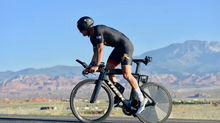Run Data Fields
- Jason Lentzke
- Jun 3, 2023
- 3 min read

Running is arguably the most pure and raw sport on the planet. There are no judges to affect the score, no teammates, no drafting, the strongest and fastest athlete simply wins: pure competition. This simplicity can be refreshing and welcoming after spending hours in the saddle staring at your power meter and other training metrics for far too long.
We recently went over Cycling Computer Data Fields , so now let’s touch on your GPS Fitness Tracker/watch’s data fields. GPS Fitness Trackers are pretty incredible tools. Beyond GPS tracking and pace information, the latest watches can provide heart rate data, run cadence and vertical oscillation. Some of the newer watches from Garmin even have a built-in metronome.
If you are in tune with your body, that Garmin computer between your ears (your brain) tends to work really well for pacing and RPE. However, it’s nice to have a GPS Fitness Tracker provide real-time objective feedback when you don’t have the brainpower to take a mental inventory of your vitals. Quenton Cassidy would destroy me for saying this, but thankfully he doesn’t exist in non-fiction form, nor was he a multisport athlete. Your wrist mounted GPS Fitness Tracker data is critical when you want it, and even more critical when you don’t.
So, what should you glance down at when you run?
That’s entirely up to you. Depending on which GPS Fitness Tracker you’re using, you will have a plethora of options. The latest Garmin GPS watches (Forerunner 920XT, 735XT & Fenix 3 models) will give you an option of displaying anywhere from 1-4 data fields/training metrics per “training page”. Earlier versions of the Forerunner will also give you customization options, just not as many. There are well over 50 different metrics you can monitor via data fields and training pages on the latest Garmin fitness watches, so you have options.
Personally, I like to run with 3 data pages displaying a variety of metrics I find useful. On the main page (Page 1)of my Garmin I like to monitor my HR and pace to see how they align and also to make sure I’m in the appropriate zone. On the top of Page 1 I have my elapsed time. At times I like to flip to Page 2 to be sure my cadence and average pace/HR is on point. I also keep track of total ascent on this page. That’s a nice metric to watch when you’re on the trail. Lastly, on my third page I simply observe temperature and time of day. I keep things fairly simple when I run, but when I need the data it’s available. Here is what my Garmin Fenix 3 looks like in action:
Page 1

Page 2

Page 3

Running is a very intimate sport. What you look at, if anything at all, is entirely up to you. Go for a run without a GPS Fitness Tracker and take a mental inventory of your body’s vitals. Try adding some of the metrics you focused on to your data fields and allow the watch to help keep you on track. It may take a while to fine tune your data fields and training pages, but once you have your watch dialed in, you won’t want to run without it.
Make the most out of your training tools and run strong. See you at the races!























